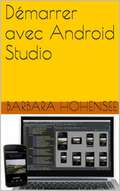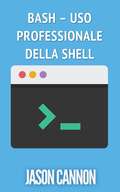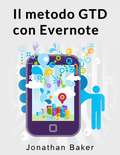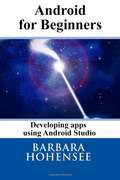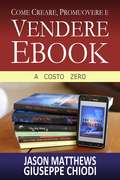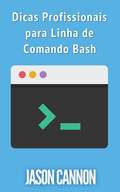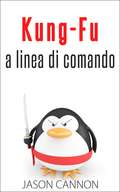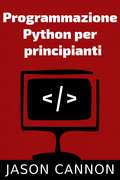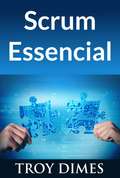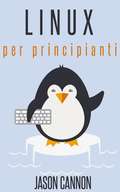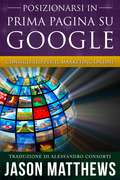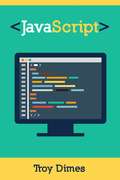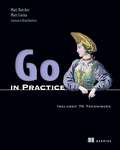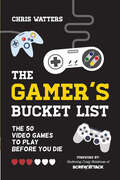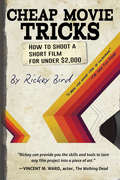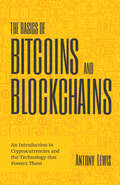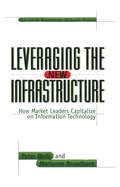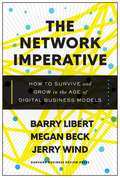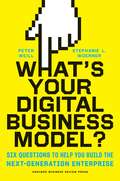- Table View
- List View
Vendere Online - Come Guadagnare Vendendo Su Ebay, Amazon, Fiverr & Etsy
by Eugenia Franzoni Nick VulichVendere online è la vostra guida passo-passo per avere successo nell'ecommerce. Questo libro vi introdurrà ai principali quattro portali di e-commerce: eBay, Amazon, Fiverr ed Etsy.***** Versione aggiornata e rivista per il 2014, include 78 pagine di nuovi contenuti, comprese sezioni sui blog e su come scrivere e vendere libri Kindle.*****Volete imparare come vendere online?L'autore, Nick Vulich, ha completato oltre 29000 transazioni su eBay negli ultimi quattordici anni; conosce le vendite su eBay, Amazon e Fiverr e vi sta offrendo la sua mano per guidarvi attraverso tutto il procedimento. Siete nuovi nell'e-commerce? Avete difficoltà o state cercando di capire come iniziare?Non vi preoccupate. Questo libro vi guiderà attraverso tutto quello che dovete sapere per iniziare a vendere online oggi.Tutti sognano di fare soldi online.Chi non vorrebbe un lavoro in cui si possa lavorare a casa in pigiama o in mutande? Un lavoro in cui non c'è un capo che ti sta alle spalle e ti dice cosa fare, come farlo e con quali tempistiche?Vendere online può realizzare questo sogno, e molto di più.Al contrario di quanto si pensi, non è facile. Non lo è affatto. Non avrete un capo che vi infastidisce dicendovi cosa fare, ma vi ritroverete a lavorare molto più duramente di quanto abbiate mai fatto nel vostro attuale lavoro.Vi potrete ritrovare in bolletta, specialmente all'inizio.Solo perché decidete di aprire un negozio su eBay, Amazon o su un qualsiasi altro negozio online non vuol dire che i clienti arriveranno magicamente a comprare da voi e vi ricopriranno di soldi. Come in tutte le cose, per avere successo nel vendere prodotti o servizi ci vuole tempo.Chiunque può andare online, pubblicare un elenco di articoli e fare un paio di vendite veloci, ma diventare un venditore di successo vuol dire replicare questo processo giorno dopo giorno e mese dopo mese.
Comment Publier Un E-Book Sans Perdre La Tête (Et Faire En Sorte Que Quelqu'un Le Lise)
by Alejandro Aguayo Lisa SchwartzSi vous avez fait l'acquisition de cet e-book, c'est parce que vous souhaitez publier un livre. Félicitations, vous avez déjà fait le plus important : prendre la décision.
Guía Del Idiota Total Para Vender En Ebay
by José Ramón Torres Nick VulichDescripción del libro:Guía del idiota total para vender en eBay es tu guía personal para hacer dinero en eBay. Su autor, Nick Vulich, ha realizado más de 29 000 transacciones en eBay en los últimos 13 años. Conoce los entresijos de las ventas en eBay y se ofrece para guiarte durante el proceso de venta.¿Te preocupa que no tengas nada que vender?No tienes por qué. Mira a tu alrededor. Todo el mundo tiene decenas de objetos en la casa y el garaje que puede empezar a vender hoy mismo. El hecho de que ya no uses tu viejo aparato de vídeo, sistema de juegos o portátil no significa que otra persona no lo quiera. A la gente le encanta las gangas. Ayúdalos a conseguir lo que quieren y échate algo de dinero al bolsillo en el proceso.Vamos a aprender cómo:Decidir qué venderAbrir una cuenta de vendedor en eBayAbrir una cuenta en PayPal (para que te paguen, RÁPIDO)Anunciar tu primer artículo en eBay con instrucciones paso a pasoOptimizar tus ventas con 28 consejos y trucosEnviar tus artículosInvestigar sobre artículos para obtener el mejor precio en cada ocasiónPrestar servicios al cliente, al estilo eBayNo dejes que el miedo te lo impida.Se calcula que más de 450 000 personas se ganan la vida vendiendo artículos en eBay.Millones de otras usan eBay para obtener dinero adicional y comprarse un coche, pagar la escuela de sus hijos o irse de vacaciones. ¿Por qué no tú?Otros millones quisieran vender en eBay, pero tienen miedo.Guía del idiota total para vender en eBay te conducirá paso a paso por el proceso de decidir qué vender, crear una cuenta en eBay y PayPal, y anunciar tu primera subasta.Todo esto se puede lograr en menos de una hora.No esperes otro minuto. ¡Pide tu copia de este libro hoy!
Fractales De Dios
by Phd Kathy J. Forti Natalia Mora ToledoA partir de la experiencia cercana a la muerte de una mujer, se desarrolla una sorprendente historia que explora las profundidades de la creación del hombre y el proyecto mismo de su creación. La sicóloga clínica, la Dra. Kathy Forti, nos comparte su experiencia en el año 2003, cuando su corazón se detuvo y fue ayudada por seres de luz multidimensionales para que volviese a la Tierra. La meta de estos seres es traer la sanación a nuestro mundo. Con sus nuevos Guías, ella investigó el mundo de las físicas y la geometría sagrada, con ello aprendió cómo cierta información matemática clave puede afectar nuestra consciencia y nuestras células. Las experiencias místicas de la Dra. Forti cambiarán para siempre sus conceptos sobre la vida, la sanación y el verdadero potencial del hombre para llegar a un cambio evolutivo. Esta profunda y reveladora historia narra el propósito de la esencia de nuestras almas, para que podamos encontrar una mayor conexión con la Fuente Divina que se encuentra en todos los seres vivos.
Démarrer Avec Android Studio
by Victor Thivillier Barbara HohenseeDémarrer avec Android studio Une introduction à Android studio Le livre donne un aperçu des nouvelles fonctionnalités et possibilités. Il commence avec l'installation et la configuration d'Android Studio. Vous prendrez connaissance du nouvel IDE et de son éditeur. Vous apprendrez à créer de nouveaux projets Android à partir de zéro, à importer sous Android Studio des projets de nature différente comme un ancien projet Eclipse ou des projets Android depuis GitHub. Le livre contient également une introduction au système de build Gradle, avec plusieurs exemples concrets. En outre, vous verrez la signature, la construction et l'exécution d'applications ainsi que leur préparation pour l'Android Market: - Captures d'écran - Signature avec l'Assistant de signature - Signature d'un apk de release en utilisant Gradle Création et exécution de projets de test dans Android Studio. Le livre contient également plusieurs exemples sur les dépendances et les bibliothèques (ActionBar Sherlock, publicité avec Admob, Google Play SDK, Api Google Maps v2) Mise en place d'un dépôt Maven local, construction de bibliothèques aar. Vous pourrez prendre connaissance des product flavors - Types de Build - Variantes de build, et apprendre à construire différents APK de partir du même projet (comprend un exemple avec 2 flavors). Développement de jeux avec AndEngine et libGDX Intégration des jeux JavaScript dans un projet Android Studio [LIME GameEngine] Développement pour Google TV Templates de code Android: - Que sont les templates de code Android - Où trouver les templates ADT (Outils de développement Android)- Création de templates de code personnalisés Le livre contient plusieurs exemples de projets complets et Android exécutables à télécharger (Code source).
Bash – Uso Professionale Della Shell
by Eugenia Franzoni Jason CannonSe vi siete mai detti "C'è un modo migliore per fare questa cosa", allora continuate a leggere.Dato che ho usato la shell Bash per oltre 15 anni quasi tutti i giorni, ho accumulato diversi "trucchi" da linea di comando che mi hanno fatto risparmiare tempo e frustrazioni. "Bash - Uso professionale della shell" è una raccolta di 10 tecniche che potete utilizzare subito per aumentare la vostra efficienza sulla linea di comando.Ecco cosa imparerete leggendo "Bash - Uso professionale della shell": Suggerimento 1: Autocompletamento con Tab Suggerimento 2: Passare alla directory precedente Suggerimento 3: Riutilizzare l'ultimo elemento della linea di comando precedente Suggerimento 4: Eseguire di nuovo un comando che inizia con una data stringa Suggerimento 5: Sostituzione dei comandi Suggerimento 6: Usare un ciclo sulla linea di comando Suggerimento 7: Eseguire di nuovo il comando precedente con privilegi di root Suggerimento 8: Eseguire di nuovo il comando sostituendo una stringa Suggerimento 9: Riusare una parola sulla stessa linea di comando Suggerimento 10: Correggere errori di digitazione ed abbreviare i comandi lunghi con degli alias
Il Metodo Gtd Con Evernote
by F. Rossi Jonathan BakerImparate come sfruttare al meglio GTD ed Evernote.Getting Things Done®, o GTD®, è una metodologia di gestione del tempo creata dal consulente di produttività David Allen. Il GTD è una delle tecniche più diffuse ed efficaci per prendere il controllo delle to-do list ed aumentare la produttività; vi aiuta non solo a portare a termine i compiti e i progetti che vi capitano sotto mano, ma anche ad avvicinarvi agli obiettivi più importanti della vostra vita.Evernote® è una applicazione software che è stata originariamente progettata per scrivere note ed archiviarle. Queste note possono essere testi, pagine web, memorandum vocali, immagini e molto altro. Evernote è ottimo per memorizzare tutti i tipi di informazione, e rende semplice organizzare e trovare i dati.Con poche informazioni, date in questo libro, potrete unire Evernote e il GTD e creare una potente macchina per aumentare la produttività. Usando Evernote e il GTD potrete organizzare il vostro lavoro e la vostra vita personale in forma elettronica. Dato che Evernote è disponibile come applicazione web e sui dispositivi mobili, potrete avere sempre accesso ai vostri compiti, progetti, obiettivi e note dovunque e in ogni momento.
Android For Beginners. Developing Apps Using Android Studio
by Barbara Hohensee Amit Dilip DharmaThe objective of this book is to give an insight into Android programming based on practical App projects. The Apps have different core focuses and hence one can extend and develop them further based on his/her Android knowledge. Thanks to active programming, the users will be quickly acquainted with the work environment and will learn how to solve problems in Android step-by-step. Android Studio, which is a completely new development environment, will be used for programming.
Come Creare, Promuovere e Vendere Ebook - A Costo Zero
by Jason Matthews Giuseppe ChiodiTutto per gli scrittori che vendono ebook. L'editoria elettronica (o e-publishing) consente agli autori indipendenti di trattenere il grosso dei diritti. Scoprite i modi migliori per: *usare i social media -- costruire una presenza online *formattare e caricare su Amazon, Narcissus, Smashwords, Barnes & Noble, Apple, Google e altri *convertire documenti in qualsiasi formato (epub, mobi, pdf e altri) *vendere libri online *creare un sito web funzionale *creare un fantastico blog *ideare copertine per ebook *scalare le classifiche col SEO (search engine optimization) su Google-Bing *vendere ebook con PayPal dai vostri stessi siti automaticamente *creare libri cartacei *usare le PR (pubbliche relazioni) per generare traffico *e molto altro Ricco di informazioni, esempi, con oltre 250 link a siti e software per realizzare i vostri obiettivi sui rivenditori e sui vostri siti web. Adatto ai principianti e utile agli esperti a cui farebbero comodo delle indicazioni in più. Come dieci libri in uno, la sola e unica fonte di cui avrete bisogno per avere successo.
Cómo hacer tu propia página web gratis: y tu blog gratis
by Jason Matthews Miguel Segura¿Quieres tener tu propia página web o aprender a cómo hacer un blog? ¿Qué te parece un creador de webs gratuito sin ningún coste mensual? Tú lo puedes hacer, es fácil para cualquiera crear una página web y empezar a publicar en tu blog con proveedores como Wordpress y Blogger, incluso si no sabes nada de diseño web. No hace falta aprender HTML porque es muy fácil con la edición WYSIWYG (what you see is what you get) (lo que ves es lo que obtienes). Este libro está escrito para que cualquiera pueda entenderlo, desde el principiante hasta los usuarios avanzados, que se beneficiarán de consejos extra. Con esta guía aprenderás a: * crear páginas web gratis * crear blogs gratis * personalizar tus widgets * vender con botones de PayPal * dirigir tráfico con Facebook, Twitter, YouTube, Google Plus * maximizar SEO (optimización de motores de búsqueda) * subir en los rankings de Google-Bing * enviar artículos y comunicados de prensa * hacer crecer una lista de contactos de correo electrónico * y mucho más Además, es divertido y se saca lo máximo de herramientas totalmente gratuitas con la garantía de ahorrarte tiempo, dinero y esfuerzo. Hoy es el día para dar el gran salto para tener tu presencia en Internet y crear tu propia página web. Los temas incuyen: Wordpress, Blogger, diseño web, página web gratis, creador de páginas web gratis, crear una página web, blogging, crear una página web, cómo publicar un blog, SEO, Google, Yola, Webs
Dicas Profissionais Para Linha De Comando Bash
by Jason Cannon Rafaella C. S. BarrosSe você já disse para si mesmo: "Tem que ter uma maneira melhor de fazer isso", então continue lendo.Como alguém que tem usado a Bash shell quase diariamente por 15 anos, acumulei vários "truques" de linha de comando que me economizaram tempo e frustrações. Dicas Profissionais para Linha de Comando Bash é uma coleção de 10 técnicas que você pode começar a usar imediatamente para aumentar sua eficiência com linha de comando.Eis o que você vai aprender lendo Dicas Profissionais para Linha de Comando Bash:Dica 1: Completar com TabDica 2: Alterar para o diretório anteriorDica 3: Reutilizar o último item da linha de comando anteriorDica 4: Executar novamente um comando que inicia com uma string fornecidaDica 5: Substituição de comandoDica 6: Usar um laço de repetição em "for" na linha de comandoDica 7: Re-executar o comando anterior com privilégios de administradorDica 8: Re-executar o comando anterior enquanto substitui uma stringDica 9: Reutilizar uma palavra na mesma linha de comandoDica 10: Corrigindo erros de digitação e encurtando comandos longos com apelidos
Kung-Fu A Linea Di Comando
by Eugenia Franzoni Jason CannonDiventate Ninja di Linux con "Kung-Fu a linea di comando"!Pensate di dovervi chiudere in cantina a leggere criptiche pagine man per mesi per poter diventare un ninja della linea di comando?In realtà, se qualcuno condivide con voi i trucchi e suggerimenti più potenti, vi potete risparmiare molto tempo e frustrazione. Cosa succederebbe se poteste stare a guardare un amico che per caso è un guru della linea di comando? E se vi mostrasse non solo i comandi che usa, ma anche perché e come funzionano esattamente? E se quell'amico scrivesse tutto in modo che possiate riguardarlo quando volete?Beh, un amico ha fatto proprio questo: questo libro è una raccolta di dozzine di suggerimenti e oltre 100 esempi di applicazione reale. Non troverete esempi teorici, ma solo soluzioni di problemi reali per arrivare a degli obiettivi validi.I contenuti sono anche facili da trovare; ogni capitolo copre un argomento specifico, e raggruppa suggerimenti ed esempi correlati; ad esempio, se dovete estrarre del testo da un file potete leggere il capitolo "Elaborazione e manipolazione dei testi".Inoltre, alla fine del libro c'è un indice completo; se volete trovare tutti gli esempi in cui viene usato uno specifico comando, anche se non è quello principale, usate l'indice, in cui c'è un collegamento a ogni posto del libro in cui il comando appare.Ecco solo alcune delle cose che imparerete leggendo "Kung-Fu a linea di comando":Come ripetere velocemente i comandi nella storia della shellScorciatoie per recuperare parole specifiche dalla storia della shell, da usare nel comando correnteCome salvare una copia della sessione a linea di comando da usare successivamenteCome togliere le linee vuote e i commenti dai fileCome controllare il testo a colori quando si usano le pipe e i paginatoriModi per trasformare il testo: dal maiuscolo e minuscolo alla sostituzione di caratteri, e molto altroCome estrarre specifici blocchi di testo dai file o dai
Programmazione Python Per Principianti
by Eugenia Franzoni Jason CannonSe volete imparare a programmare in Python ma non sapete da dove iniziare, continuate a leggere.Sapere dove iniziare quando si impara qualcosa di nuovo può essere un problema, soprattutto se l'argomento sembra così vasto. Ci possono essere così tante informazioni a disposizione che non si riesce nemmeno a decidere da dove iniziare, o peggio, si comincia ad imparare e si scoprono velocemente così tanti concetti, esempi di programmazione e dettagli che non vengono spiegati. Questo tipo di esperienza è frustrante e lascia con più domande che risposte.Programmazione Python per principianti non dà per scontato niente su quello che già conoscete della programmazione o del linguaggio Python. Non serve sapere niente per trarre beneficio da questo libro. Verrete guidati passo dopo passo usando un approccio logico e sistematico. A mano a mano che incontrerete nuovi concetti, codice e termini, questi verranno spiegati in linguaggio chiaro, rendendo semplice comprenderli per chiunque.Ecco cosa imparerete leggendo questo libro:Quando usare Python 2 e quando Python 3.Come installare Python su Windows, Mac e Linux, con gli screenshots.Come preparare il computer per programmare in Python.I vari modi di eseguire programmi Python su Windows, Mac e Linux.I migliori editor di testo e ambienti di sviluppo integrati per scrivere codice.Come lavorare con vari tipi di dato: stringhe, liste, tuple, dizionari, booleani ed altri.Cosa sono le variabili e quando usarle.Come fare operazioni matematiche in Python.Come prendere l'input utente.Come controllare il flusso dei programmi.L'importanza degli spazi in Python.Come organizzare i programmi, cosa va dove.Cosa sono i moduli, quando usarli e come crearne di vostri.Come definire e usare le funzioni.Importare le funzioni Python che si usano di frequente.Come leggere e s
Scrum Essencial
by Troy Dimes Rafaella C. S. BarrosDesenvolvimento de Software Ágil Usando ScrumCrie softwares que agreguem mais valorIdeias são baratas. Muitas pessoas parecem pensar que a maior parte do processo de desenvolvimento de software é apenas criar um conceito vago de uma aplicação que as pessoas podem querer. Você provavelmente já escutou muitas pessoas dizerem coisas como: "Tenho uma ideia para um aplicativo que certamente terá um milhão de downloads!", apenas para ter mais um aplicativo em um mar de aplicativos similares.Criar softwares ótimos e entregá-los no prazo precisa de um esquema de implementação sistemático, mas que não seja excessivamente rígido. Qualidade e tempo devem andar juntos. Se você entregar um software que esteja cheio de bugs ou com uma experiência ao usuário ruim, você certamente não poderá contar com outra negociação com seu cliente. Muitos programadores temem esse resultado e, por conta disso, demoram muito para criar programas.Você tem uma quantidade de tempo limitada para criar software, especialmente quando você tem um prazo, que você mesmo impôs ou não. É importante que você tenha certeza que o software que você construiu é bom o suficiente, mas ainda mais importante, que esteja no prazo. Como você equilibra qualidade e tempo?Esse livro mergulha nesses tópicos muito importantes. Após ler Scrum Essencial, você entenderá sobre os papéis do scrum, sprints, artefatos scrum e muito mais. Eis o que você aprenderá lendo Scrum Essencial:· O que é a Metodologia Cascata e porque você não deveria usar este método para executar seus projetos de software· O que é Scrum, sua origem, porque você deveria usá-lo e como você pode encontrar um uso prático na sua organização hoje· A diferença entre Scrum e o desenvolvimento de software ágil· Os vários papeis Scrum incluindo o Product Owner, Scrum
Linux Per Principianti
by Eugenia Franzoni Jason CannonSe volete imparare ad usare Linux ma non sapete dove iniziare, continuate a leggere.Sapere dove iniziare quando si impara qualcosa di nuovo può essere un problem,a soprattutto se l'argomento sembra così vasto. Ci possono essere così tante informazioni a disposizione che non si riesce nemmeno a decidere da dove iniziare, o peggio, si comincia ad imparare e si scoprono velocemente così tanti concetti, esempi di programmazione e dettagli che non vengono spiegati. Questo tipo di esperienza è frustrante e lascia con più domande che risposte.Linux per principianti non dà per scontato niente su quello che già conoscete di Linux. Non serve sapere niente per trarre beneficio da questo libro. Verrete guidati passo dopo passo usando un approccio logico e sistematico. A mano a mano che incontrerete nuovi concetti, codice e termini, questi verranno spiegati in linguaggio chiaro, rendendo semplice comprenderli per chiunque.Ecco cosa imparerete leggendo Linux per principianti:Come accedere ad un server Linux se non ne avete uno.Cosa è una distribuzione di Linux e come sceglierne una.Quale software serve per connettersi a Linux da computer Mac e Windows, con gli screenshot.Cosa è SSH e come usarla, compresa la creazione di chiavi SSH.La struttura del filesystem di Linux e dove trovare i programmi, i file di configurazione e la documentazione.I comandi Linux di base che userete più spesso.Creare, rinominare, spostare e cancellare le directory.Elencare, leggere, creare, modificare, copiare e cancellare i file.Come funzionano esattamente i permessi e come decifrare quelli più strani con facilità.Come usare gli editor nano, vi ed emacs.Due metodi per cercare file e directory.Come paragonare il contenuto dei file.Cosa sono le pipe, perché sono utili e come usarle.Come comprimere i file per risparmiare spazio e trasferirli facilmente.Come e perché redirigere l'input e l'output delle applicazioni.Come person
Posizionarsi in Prima Pagina su Google - Consigli SEO per il Marketing Online
by Jason Matthews Alessandro ConsortiArrivare in prima pagina su Google tramite facili suggerimenti SEO. Semplicemente tramite il SEO (search engine optimization) si può far arrivare qualsiasi sito in cima, senza spendere soldi. Scoprite nuovi modi di usare le parole chiave, i meta description ed i tag, categorie/etichette, titoli, costruzione di link ed altro. Istruzioni dettagliate per aiutare il vostro sito a raggiungere la prima pagina di Google. Tutti possono farcela. Non costa nulla a parte un po' di tempo. Scoprirete: *le migliori parole chiave, sia di tipo short-tail che long-tail *meta tag con meta description nel sorgente della pagina *modi di ottimizzare testo ed immagini *collegamenti URL di ritorno verso altri siti *come monitorare le tendenze dei visitatori *piattaforme online e come incrementare la visibilità *strumenti per il social media (Google Plus, Facebook, Twitter, ecc.) *come collegarsi con persone di tutto il mondo *molto altro... In un periodo che va da poche settimane a qualche mese, vedrete risultati reali ed arriverete in prima pagina. Argomenti trattati: SEO, suggerimenti SEO, Google, Google AdWords, ottimizzazione dei motori di ricerca, marketing online, business online, internet marketing, internet business, e-commerce, e-business, parole chiave, keyword planner, ricerca delle parole chiave, blog, blogging, AdWords, Bing
Javascript: Un Manuale Per Imparare La Programmazione In Javascript
by Eugenia Franzoni Troy DimesImparate il JavaScript JavaScript è un linguaggio di programmazione dinamico che viene spesso usato nei browser per controllare il comportamento delle pagine web e per interagire con gli utenti; permette la comunicazione asincrona e può aggiornare parti delle pagine web o addirittura sostituirne completamente il contenuto. Vedrete JavaScript usato per visualizzare informazioni sulla data e l'ora, per fare delle animazioni su un sito web, per validare i dati inseriti in un form, per suggerire dei risultati mentre l'utente scrive in un campo di ricerca e molto altro. JavaScript viene usato sempre di più... Anche se JavaScript è il linguaggio di programmazione client side al giorno d'oggi più diffuso, può essere usato anche come linguaggio server side; ne sono alcuni esempi Node.js, Meteor, Wakanda, CouchDB e MongoDB. Il tempo che investirete imparandolo può darvi un risultato doppio, perché questo linguaggio continua ad espandersi in sempre più aree dell'informatica. Imparate i fondamentali del linguaggio di programmazione JavaScript Non importa se volete usare JavaScript in un browser web come linguaggio client, come linguaggio server o entrambi, dovrete impararne prima i fondamenti. Questo è ciò che vi darà questo libro; quando finirete di leggerlo, vi sentirete a vostro agio nel programmare in JavaScript. Ecco alcune cose che imparerete leggendo questo libro: Quando si può usare JavaScript Come impostare il computer in modo che sia facile e comodo programmare in JavaScript Quali strumenti vi servono per programmare in JavaScript Le basi di HTML... Cosa sono le variabili e come usarle Come gestire i numeri e fare le operazioni matematiche Come e quando usare i condizionali Cosa sono le funzioni, perché sono così comode e come farne buon uso Strutture di dati avanzate come gli array associativi Molto altro... Tornate s
Go in Practice
by Matt Butcher Matt FarinaThis practical handbook builds on the foundational concepts of the Go language and introduces specific strategies you can use in your day-to-day applications. <P><P>You'll learn techniques for building web services, using Go in the cloud, testing and debugging, routing, network applications, and much more. <P><P>After finishing this book, you will be ready to build sophisticated cloud-native Go applications.
Test Yourself On Build a Large Language Model (From Scratch)
by Curated From Build A Large Language ModelSebastian Raschka&’s bestselling book Build a Large Language Model (From Scratch) is the best way to learn how Large Language Models function. Summary With over 350 pages in seven chapters and five Appendixes, it guides you step-by-step in building an entire large language model similar to GPT-2. It uses Python and the PyTorch deep learning library. It&’s a unique way to learn this subject, which some believe is the only way to truly learn: you build a model yourself. Even with the clear explanations, diagrams, and code in the book, learning a complex subject is still hard. This Test Yourself guide intends to make it a little easier. The structure mirrors the structure of Build a Large Language Model (From Scratch), focusing on key concepts from each chapter. You can test yourself with multiple-choice quizzes, questions on code and key concepts, and questions with longer answers that push you to think critically. The answers to all questions are provided. Depending on what you know at any point, this Test Yourself guide can help you in different ways. It will solidify your knowledge if used after reading a chapter. But it will also benefit you if you digest it before reading. By testing yourself on the main concepts and their relationships you are primed to navigate a chapter more easily and be ready for its messages. We recommend using it before and after reading, as well as later when you have started forgetting. Repeated learning solidifies our knowledge and integrates it with related knowledge already in our long-term memory. What's inside • Questions on code and key concepts • Critical thinking exercises requiring longer answers • Answers for all questions About the reader For readers of Build a Large Language Model (From Scratch) who want to enhance their learning with exercises and self-assessment tools. About the author Curated from Build a Large Language Model (From Scratch).
The Gamer's Bucket List: The 50 Video Games to Play Before You Die
by Chris WattersWhich games are worth playing?---------- From pixelated pioneer adventures to stunning space odysseys, the boundaries of the video game world are expanding every day. Grand epics and gritty mysteries. Fierce competition and friendly cooperation. Powerful emotions and uproarious laughter. Video games are fantastically diverse and wonderfully creative, but not all games are created equal. With so many games out there on so many different consoles, computers, and devices, how do you decide which games are worth playing? Backed by years of writing about games professionally and decades spent playing them, Chris Watters lays out a list of 50 games to entertain and enlighten you. Whether you’re trying to learn more about the world of gaming or strengthening your claim to true gaming fluency, these are the games you’ll want to play, and why you’ll want to play them.
Cheap Movie Tricks: How To Shoot A Short Film For Under $2,000
by Rickey BirdHow to Make a Movie on a Tight BudgetToday’s indie film market is growing by leaps and bounds and filmmaker Rickey Bird and screenwriter and novelist Al Guevara are on a mission to help indie moviemakers everywhere.Bird and Guevara want to show aspiring filmmakers how to overcome common movie and video production problems:Not enough money for crewsOver budget and likely making the wrong movieCan’t get the attention of an indie studioShould have started with a short film to gain attentionAmateur Movie & Video Production. Thousands of aspiring filmmakers are learning how to use cheaper, widely available filmmaking technology, and the craft of making movies from books pulled from bookstore and library shelves. Their work is totally DIY and they are the most creative people you will ever meet. Rickey Bird’s Hectic Films is a Southern California enterprise building a filmmaking empire on a budget. His short films, feature films, micro docs and tutorials have landed in some of the biggest American film festivals and been seen online worldwide. The result? Millions of views worth of exposure from films online, in festivals and creative marketing literally on the street. His many projects have seen leading B actors like Hulk Hogan and Vernon Wells (Mad Max Road Warrior), make-up artists from the TV show Grimm, and stuntmen from the Call of Duty games.What you’ll learn in this book:How planning and shooting a short film today can lead to a feature-length project tomorrowEverything you need to know about writing a movie project on a burger budgetTips on how to find locations and not get arrestedShooting tips galore for building exciting scenesSound and film editing tips and all kinds of special effects wizardry, including puppetryScreenings, promotions, and juicy tips on film festival strategyIf you liked books such as How to Shoot Video That Doesn't Suck, The Filmmaker's Handbook, or Rebel Without a Crew, you’ll love Cheap Movie Tricks.
The Basics of Bitcoins and Blockchains: An Introduction to Cryptocurrencies and the Technology that Powers Them
by Antony LewisDiscover the Surprising History of Ordinary Things"Emily magically weaves a vibrant history of simple everyday objects we often take for granted. The Story Behind will surprise and delight..." ─Deana Marie, Creator & Host of the Twisted Philly podcast#1 Best Seller in Trivia & Fun Facts, Art History, Design History & Criticism, Reference, Decorative Arts & Design, and History of TechnologyLearn the fascinating history and trivia you never knew about things we use daily, from the host of The Story Behind podcast.Everyday objects and major events in history. Every single thing that surrounds us has a story behind it. Many of us learn the history of humans and the major inventions that shaped our world. But what you may not have learned is the history of objects we surround ourselves with every day. You might not even know how the major events in history (World Wars, ancient civilizations, revolutions, etc.) influenced the inventions of things we use today.The history and science behind the ordinary. From the creator of The Story Behind podcast comes one of the coolest coffee table books ever written. The Story Behind provides insight into everyday objects we don’t think much about as we use them. Topics covered in Emily’s podcast are examined in more detail along with new fascinating topics. Learn how lollipops got started in Ancient Egypt, how podcasts were invented, and why Comic Sans was created. Learn the torture device origins of certain exercise equipment and the espionage beginnings of certain musical instruments. Ordinary things from science to art, food to sports, customs to fashion, and more are explored.Inside:Learn obscure history and fun facts and change the way you see the worldDiscover how major historic events still affect us todayBecome a formidable trivia masterIf you have enjoyed books such as Now I Know, What If?, Ever Wonder Why?, The Greatest Stories Never Told, or Atlas Obscura; you will be entertained by The Story Behind.
Leveraging the New Infrastructure
by Peter Weill Marianne BroadbentImagine thinking about your company's information technology in the same way that you think about its investment portfolio: as a bundle of assets that--when managed right--will generate revenues and savings. Here's just such a framework for leveraging IT (technology, networks, data, and software)--one that enables business managers to make the important decisions about the potentially confounding mix of high-technology that influences near- and long-term planning, affects the ability to support customers, and dictates the flow of daily operations. Drawing upon their rigorous research with more than 100 top multinationals, the authors present a rich and varied range of examples of IT investment strategies that have reaped rewards for firms such as Citibank, Honda, Johnson & Johnson, Ralston Purina, the Development Bank of Singapore, and Telstra. This hands-on resource, compete with benchmarks and case studies, creates the common ground where both management and IT can meet, communicate their goals, and agree on the best plan for getting there.
The Network Imperative: How to Survive and Grow in the Age of Digital Business Models
by Barry Libert Jerry Wind Megan BeckDigital networks are changing all the rules of business. New, scalable, digitally networked business models, like those of Amazon, Google, Uber, and Airbnb, are affecting growth, scale, and profit potential for companies in every industry. But this seismic shift isn't unique to digital start-ups and tech superstars. Digital transformation is affecting every business sector, and as investor capital, top talent, and customers shift toward network-centric organizations, the performance gap between early and late adopters is widening.So the question isn't whether your organization needs to change, but when and how much.The Network Imperative is a call to action for managers and executives to embrace network-based business models. The benefits are indisputable: companies that leverage digital platforms to co-create and share value with networks of employees, customers, and suppliers are fast outpacing the market. These companies, or network orchestrators, grow faster, scale with lower marginal cost, and generate the highest revenue multipliers.Supported by research that covers fifteen hundred companies, authors Barry Libert, Megan Beck, and Jerry Wind guide leaders and investors through the ten principles that all organizations can use to grow and profit regardless of their industry. They also share a five-step process for pivoting an organization toward a more scalable and profitable business model.The Network Imperative, brimming with compelling case studies and actionable advice, provides managers with what they really need: new tools and frameworks to generate unprecedented value in a rapidly changing age.
What's Your Digital Business Model?: Six Questions to Help You Build the Next-Generation Enterprise
by Peter Weill Stephanie Woerner<p>What is your digital business model? While many leaders of companies recognize the threat from digital--and the potential opportunity--they lack a common language or a compelling framework to help them assess it and, more importantly, to direct them. They don't know how to think about their digital business model. In this probing and practical book, Peter Weill and Stephanie Woerner provide much-needed tools, self-assessments, motivating examples, and key financial analyses of where the profits will likely be made. <p>Based on five years of study at the MIT Center for Information Systems Research, the book provides a powerful yet simple framework that has been field-tested globally with more than a dozen senior management teams. The authors found that digitization is moving companies' business models on two dimensions: from value chains to digital ecosystems, and from a fuzzy understanding of the needs of end customers to a sharper one. Looking at these dimensions in combination results in four distinct business models, each with different capabilities: (1) Supplier, (2) Omni-channel, (3) Modular Producer, and (4) Ecosystem Driver. The framework helps companies clarify where they are currently in an increasingly digital business landscape and highlights what's needed to move toward another, higher-value digital business model. <p>In meeting the growing challenge to "go digital," this smart book will help you grapple with the threats, respond to the opportunities, and create winning digital strategies.</p>




